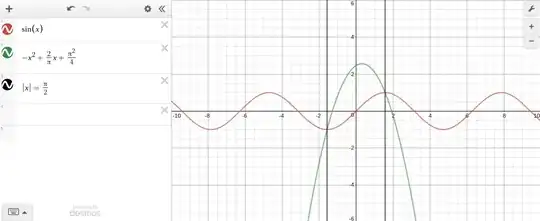In Calculus class, we are all taught how to find the volume of a solid of rotation around any line of the form $y=a$ or $x=b$. Then in linear algebra, we are taught how to find the volume of a solid of rotation around a line of the form $y=mx$ by using the rotation matrix, $\begin{bmatrix}
\cos (x) & -\sin (x)\\
\sin (x) & \cos (x)
\end{bmatrix}$. But is it possible to find the volume of a solid that is rotated around a non-linear axis of rotation? For example, let's say that we are rotating the function $f(x) = -x^{2} + \frac{2}{\pi } x + \frac{\pi ^{2}}{4}$ around axis of rotation $g(x) = \sin (x)$. Notice that f(x) only intersects with g(x) at two points: $\left ( -\frac{\pi }{2},-1 \right )$ and $\left ( \frac{\pi }{2},1 \right )$. So we are only rotating f(x) around g(x) between those two intersections. I provide an image just to help with visualization. The red function is the axis of rotation, the green function is the function which we are rotating, and the black lines represent the bounds of rotation. My question is then, what is the volume of that solid of rotation? The only thing I found related to this was from this question,Solids of Revolution around other functions. , but the question was still left unanswered and this question is just a slight variant of that one. 
edit: Based on the comments, I tried to come up with a way to define a rotation around a non-linear axis, and this is what I have come up with. Let us cover the non-linear axis of rotation with an abundance of tangent lines of length $\Delta L $. We can rotate a function around each of those lines of length $\Delta L $. The solid of rotation would then be the solid that comes from combining all the solids generated from rotating around each of those tangent lines of length $\Delta L $ as $\Delta L \rightarrow 0$ Would this make sense as a definition of rotating around a non-linear axis?
2nd edit: In the comments, you can find a better definition to define this concept.